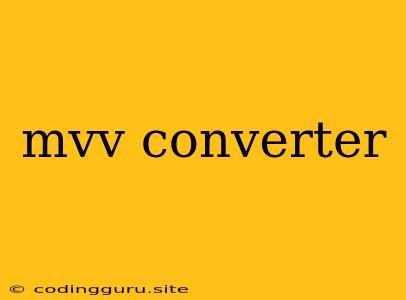What is an MVV Converter?
An MVV converter, also known as a Model-View-ViewModel (MVVM) Converter, is a crucial component within the MVVM (Model-View-ViewModel) architectural pattern. It acts as a bridge between the View and the ViewModel, enabling the transformation of data between these two layers.
Think of it like a translator: You have one language (the data model) and need to speak another (the view). The MVV converter helps you translate between these languages.
Why Use an MVV Converter?
- Data Transformation: MVV Converters allow you to modify data before displaying it in the View. This includes formatting, filtering, or even creating new data based on existing values.
- Separation of Concerns: By handling data transformation within the converter, you keep the View and ViewModel clean and focused on their specific responsibilities.
- Reusability: You can easily reuse converters across different ViewModels and Views, promoting code modularity and efficiency.
- Testability: MVV Converters can be easily tested in isolation, ensuring the correctness of your data transformations.
How Does an MVV Converter Work?
Let's break down the process with a simple example:
Imagine you have a ViewModel containing a DateTime object representing a user's birthdate. Your View needs to display the birthdate in a user-friendly format, like "Born on March 15, 1985".
- Data Binding: The View binds a property to the ViewModel's birthdate.
- Converter Binding: You bind the property with an MVV Converter.
- Conversion: The converter receives the DateTime object from the ViewModel.
- Transformation: It applies the desired formatting logic to the date, creating a new formatted string "Born on March 15, 1985".
- Output: The converter returns the formatted string, which is displayed in the View.
Example Implementation (Using .NET)
public class DateConverter : IValueConverter
{
public object Convert(object value, Type targetType, object parameter, CultureInfo culture)
{
if (value is DateTime dateTime)
{
return $"Born on {dateTime.ToString("MMMM dd, yyyy")}";
}
return "";
}
public object ConvertBack(object value, Type targetType, object parameter, CultureInfo culture)
{
// Implement logic for converting back from the formatted string to DateTime if needed.
return null;
}
}
Explanation:
IValueConverter: This interface defines the contract for converters in .NET.Convert: This method takes the ViewModel's birthdate (DateTime) and converts it to the formatted string.ConvertBack: This method is optional and handles the reverse conversion, which might be needed for user input.
Advantages of Using MVV Converters
- Improved Code Organization: The MVV pattern promotes better separation of concerns, and MVV Converters contribute to this by isolating data transformation logic.
- Enhanced Code Reusability: Converters can be reused across multiple Views and ViewModels, reducing redundancy and improving code maintainability.
- Simplified Testing: Converters can be unit-tested independently from the View and ViewModel, making testing easier and more efficient.
- Flexible Data Handling: Converters enable the manipulation of data to meet the specific requirements of the View, providing greater flexibility.
Summary
MVV Converters are essential components of the MVVM pattern, allowing for seamless data transformation between the View and ViewModel. They improve code organization, reusability, testability, and flexibility, making MVVM development more efficient and maintainable.
By using MVV Converters, you can ensure that your View displays data in the desired format while keeping the ViewModel focused on business logic.
